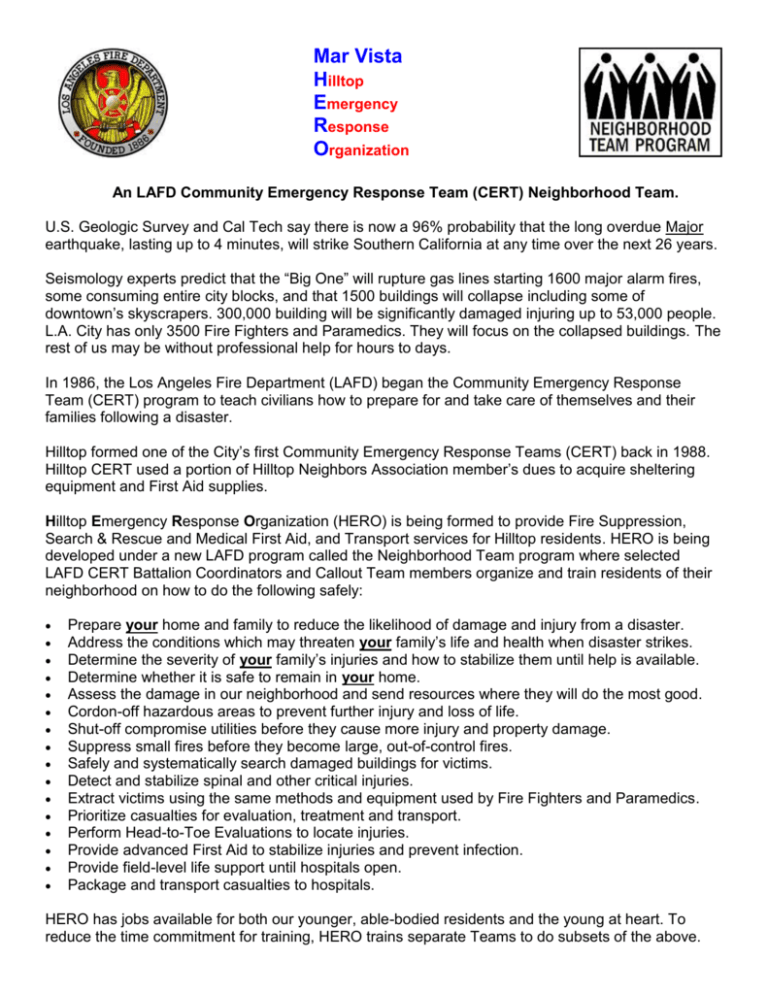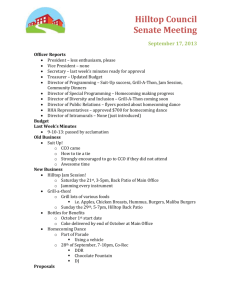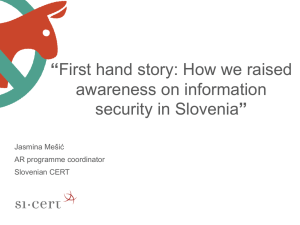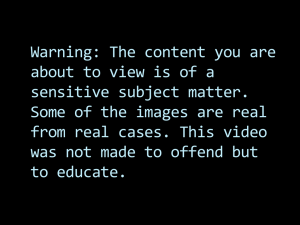Overview Flier - HERO
advertisement

Mar Vista Hilltop Emergency Response Organization An LAFD Community Emergency Response Team (CERT) Neighborhood Team. U.S. Geologic Survey and Cal Tech say there is now a 96% probability that the long overdue Major earthquake, lasting up to 4 minutes, will strike Southern California at any time over the next 26 years. Seismology experts predict that the “Big One” will rupture gas lines starting 1600 major alarm fires, some consuming entire city blocks, and that 1500 buildings will collapse including some of downtown’s skyscrapers. 300,000 building will be significantly damaged injuring up to 53,000 people. L.A. City has only 3500 Fire Fighters and Paramedics. They will focus on the collapsed buildings. The rest of us may be without professional help for hours to days. In 1986, the Los Angeles Fire Department (LAFD) began the Community Emergency Response Team (CERT) program to teach civilians how to prepare for and take care of themselves and their families following a disaster. Hilltop formed one of the City’s first Community Emergency Response Teams (CERT) back in 1988. Hilltop CERT used a portion of Hilltop Neighbors Association member’s dues to acquire sheltering equipment and First Aid supplies. Hilltop Emergency Response Organization (HERO) is being formed to provide Fire Suppression, Search & Rescue and Medical First Aid, and Transport services for Hilltop residents. HERO is being developed under a new LAFD program called the Neighborhood Team program where selected LAFD CERT Battalion Coordinators and Callout Team members organize and train residents of their neighborhood on how to do the following safely: Prepare your home and family to reduce the likelihood of damage and injury from a disaster. Address the conditions which may threaten your family’s life and health when disaster strikes. Determine the severity of your family’s injuries and how to stabilize them until help is available. Determine whether it is safe to remain in your home. Assess the damage in our neighborhood and send resources where they will do the most good. Cordon-off hazardous areas to prevent further injury and loss of life. Shut-off compromise utilities before they cause more injury and property damage. Suppress small fires before they become large, out-of-control fires. Safely and systematically search damaged buildings for victims. Detect and stabilize spinal and other critical injuries. Extract victims using the same methods and equipment used by Fire Fighters and Paramedics. Prioritize casualties for evaluation, treatment and transport. Perform Head-to-Toe Evaluations to locate injuries. Provide advanced First Aid to stabilize injuries and prevent infection. Provide field-level life support until hospitals open. Package and transport casualties to hospitals. HERO has jobs available for both our younger, able-bodied residents and the young at heart. To reduce the time commitment for training, HERO trains separate Teams to do subsets of the above. Command Post Officers record incidents, and allocate and track resources. These are great jobs for retired people and others normally in the neighborhood. Job Requirements: Decision making, direction, documentation, ability to work outside for four hours. Damage Survey Teams conduct a windshield survey of the neighborhood looking for obvious damage, check on the elderly and mobility impaired, check on homes not displaying “We’re OK” sign, use radios to request Fire Suppression, Search & Rescue and/or Medical Teams as needed. Job Requirements: Drive and walk for up to two hours at a time. Incident Commanders lead Fire Suppression, Search & Rescue and/or Medical Teams to places where incidents have occurred and serve as safety officers for the teams assigned to them. ICs do not get involved in rescue operations. Job Requirements: Ability to lead and mange others. Fire Suppression Teams work in teams to suppress small fires using large fire extinguishers and small fire hoses. Job Requirements: Run while carrying a 20 lb. extinguisher. Search & Rescue Teams perform Structure Triage, Hazards Size-Up, Utility Management, and use Systematic Search Patterns to extract victims from Light and Moderately Damage buildings. They also may help load casualties for Transport. Job Requirements: Lift and carry 60 lbs. for 60 feet. Medical Teams perform Casualty Triage, Head-to-Toe Injury Evaluation, First Aid Treatment and assist in packaging casualties for transport. Job Requirements: Non-hemophobic. Give First Aid. Transport Teams check the status of roads to hospitals and transport casualties to hospitals or to the Command Center for care and observation. Job Requirements: Have a van or truck. HERO training consists of 1 to 5 two-hour sessions depending on the Team you choose. The training is highly Hands-On. Classes are offered once a year on both Thursday and Sunday evening to accommodate busy, changing schedules. Team members must be at least 18 years of age. If you are interested in joining HERO, click Reply, fill-in the information below and click Send. Name - _______________ Address - ________________ Home Phone - _____________ Cell Phone - ______________ For which Team(s) are you interested in training and serving: Command Post Operations - __ Damage Survey - __ Fire Suppression - __ Search & Rescue - __ Medical - __ Transport - __ If you have any questions, please contact me at BillPope1@verizon.net or 310-391-3887. The life you learn to save may be that of a family member, ... or even your own. Bill Pope Mar Vista Hilltop Emergency Response Organization (HERO) Organizer Member, Los Angeles Fire Department Call-Out Team Author, CERT Field GuideBook







